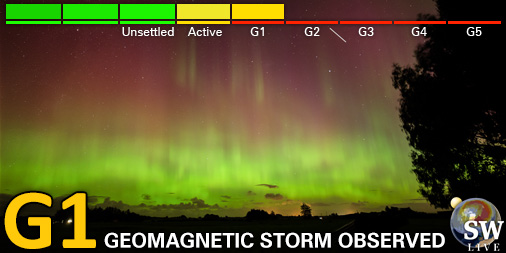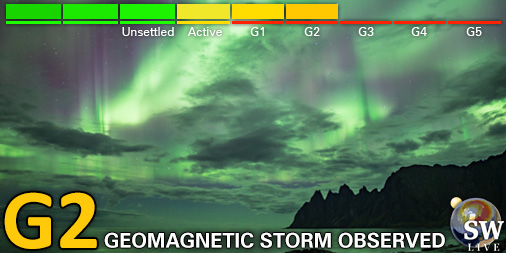Viewing archive of Wednesday, 14 September 2005
Solar activity report
Any mentioned solar flare in this report has a scaling factor applied by the Space Weather Prediction Center (SWPC). Because of the SWPC scaling factor, solar flares are reported as 42% smaller than for the science quality data. The scaling factor has been removed from our archived solar flare data to reflect the true physical units.
Report of Solar-Geophysical Activity 2005 Sep 14 2216 UTCPrepared by the NOAA © SWPC and processed by SpaceWeatherLive.com
Joint USAF/NOAA Report of Solar and Geophysical Activity
SDF Number 257 Issued at 2200Z on 14 Sep 2005IA. Analysis of Solar Active Regions and Activity from 13-2100Z to 14-2100Z
Solar activity continues at high levels. An impulsive
X1.7/1b flare was observed at 13/2322 UTC from Region 808 (S11W10).
This flare occurred during the decay phase of yesterdays double peak
X1 proton flare. This X1.7 event had an associated 180 sfu tenflare.
Region 808 exhibited little change over the past 24 hours and still
maintains a strong beta-gamma-delta magnetic configuration.
IB. Solar Activity Forecast
Solar activity is expected to be
moderate to high. Region 808 has the potential for further M and
X-class flares.
IIA. Geophysical Activity Summary 13-2100Z to 14-2100Z
The geomagnetic field was at unsettled to minor storm levels. Minor
storm conditions were the result of elevated solar wind speeds and
long periods of southward Bz in the IMF. The greater than 10 MeV
proton flux crossed the 10 pfu event threshold at 14/0040 UTC in
response to an influx of energetic particles from the recent X1
flares late on 13 September. This new proton enhancement reached a
maximum of 183 pfu at 14/1520 UTC before declining to around 50 pfu
by the end of the period. The greater than 2 MeV electron flux at
geosynchronous orbit was at high levels again today.
IIB. Geophysical Activity Forecast
The geomagnetic field is
expected to reach major to severe storm levels on 15 September
following the anticipated arrival of the CME associated with the 13
September X1 flares. Minor storm to major storm periods are possible
on 16 September decreasing to mostly unsettled by 17 September. The
greater than 10 MeV proton event may increase temporarily with the
shock arrival.
III. Event Probabilities 15 Sep to 17 Sep
| Class M | 75% | 70% | 65% |
| Class X | 50% | 40% | 40% |
| Proton | 99% | 60% | 40% |
| PCAF | in progress | ||
IV. Penticton 10.7 cm Flux
Observed 14 Sep 117 Predicted 15 Sep-17 Sep 110/110/105 90 Day Mean 14 Sep 092
V. Geomagnetic A Indices
Observed Afr/Ap 13 Sep 026/051 Estimated Afr/Ap 14 Sep 018/025 Predicted Afr/Ap 15 Sep-17 Sep 050/075-018/030-008/015
VI. Geomagnetic Activity Probabilities 15 Sep to 17 Sep
| A. Middle Latitudes | |||
|---|---|---|---|
| Active | 10% | 35% | 20% |
| Minor storm | 20% | 20% | 10% |
| Major-severe storm | 60% | 10% | 01% |
| B. High Latitudes | |||
|---|---|---|---|
| Active | 10% | 35% | 30% |
| Minor storm | 20% | 35% | 15% |
| Major-severe storm | 70% | 20% | 05% |
All times in UTC
Latest news
Latest forum messages
Incoming & Unnumbered Active Regions 1661Unspecified geomagnetic activity 2221AR4048 114New satellites - Proba-3, PUNCH, SWFO-L1, GOES-U/19 36Filaments and prominences 750
More topicsSupport SpaceWeatherLive.com!
A lot of people come to SpaceWeatherLive to follow the Sun's activity or if there is aurora to be seen, but with more traffic comes higher server costs. Consider a donation if you enjoy SpaceWeatherLive so we can keep the website online!

Latest alerts
10:00 UTC - Hemispheric Power Index
The OVATION model predicts the Hemispheric Power Index to reach 78GW at 10:32 UTC
04:15 UTC - Geomagnetic activity
Minor G1 geomagnetic storm (Kp5) Threshold Reached: 04:05 UTC
03:15 UTC - Geomagnetic activity
Moderate G2 geomagnetic storm (Kp6) Threshold Reached: 02:59 UTC
01:00 UTC - Geomagnetic activity
Minor G1 geomagnetic storm (Kp5) Threshold Reached: 00:51 UTC
Friday, 4 April 2025
23:30 UTC - Geomagnetic activity
Minor G1 geomagnetic storm (Kp5) Threshold Reached: 23:17 UTC
Space weather facts
| Last X-flare | 2025/03/28 | X1.1 |
| Last M-flare | 2025/04/01 | M2.5 |
| Last geomagnetic storm | 2025/04/04 | Kp5+ (G1) |
| Spotless days | |
|---|---|
| Last spotless day | 2022/06/08 |
| Monthly mean Sunspot Number | |
|---|---|
| March 2025 | 134.2 -20.4 |
| April 2025 | 148 +13.8 |
| Last 30 days | 130.9 -15.2 |






